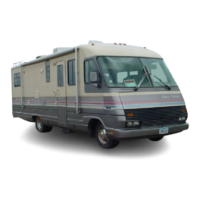18
Discovery, Discovery LXE, Pace Arrow, and Pace Arrow LXEt
WARNING:
Because many styles of
safety and booster seats
are available, refer to the
safety seat OEM manual for
proper installation and how
to properly install and secure
the safety or booster seat.
Seat Belt Care:
Keep the belt clean and dry.
Clean with mild soap and
lukewarm water. Do not use
bleach, dye or abrasive cleansers
that may weaken the belt material.
Periodically inspect belts for
cuts, frays or loose parts, and
replace damaged parts. Do not
disassemble or modify the system.
Replace the seat belt assembly
after a severe impact, even when
damage is not obvious.
DRIVING TIPS
CAUTION:
State laws in the United
States and provincial laws
in Canada vary concerning
operator licensing
requirements and vehicle
dimensional restrictions.
Check the laws in the
area where you anticipate
traveling.
The motorhome is a complex
vehicle that requires increased
driving awareness because of its
size and various components.
Turning radius will be much
wider than that of a standard
automobile due to increased
length. Pay close attention to
the perimeter of the motorhome
including front, sides, rear, roof
and undercarriage. Ensure the
surrounding area is clear of
obstacles. Use the mirrors to
observe trafc conditions as well
as the exterior including tires,
bay doors, blind spots, etc.
Use a push-pull method
of steering, with both hands
parallel on the steering wheel.
The motorhome is considerably
heavier than an automobile and has
a higher center of gravity. These
factors will necessitate advanced
reaction time. Swerving and sharp
cornering performed high speeds
could result in loss of control.
Keep size and weight of the
motorhome in mind. Drive
with increased caution to avoid
situations that might require quick
momentum changes. Increase
reaction time by paying attention
to trafc and road conditions 12 to
15 seconds ahead.
The motorhome will travel
safely and comfortably at
highway speed limits. However, it
takes more time to reach highway
speed. When passing another
vehicle, allow extra time and
space to complete the pass due to
increased length.
Manually shift
to a lower gear
when descending
a long hill. Begin
the descent at a
slow speed. Do not allow the
motorhome to gain momentum
before trying to slow down. Use
the engine brake and transmission
in conjunction with the service
brakes to help maintain a slow,
safe descent. The transmission
and engine will help control
downhill speed and can extend
the service life of the brake lining.
Distance required to stop the
motorhome is greater than an
automobile. Practice stopping
away from trafc to get the feel
of distance required to stop.
Note weight limits of bridges
before crossing. Signs should
be posted at bridge entrances.
Check posted height of all
overpasses and situations where
overhead clearance is limited.
Keep in mind road surfaces
may be repaved or packed with
snow; therefore, the actual posted
clearance would be less in such
conditions.
Use the pilot seat controls to
comfortably position the seat.
Stay seated and adjust the outside
mirrors if necessary to gain a clear
line of vision down both sides of
the motorhome.
Adjust to Driving Conditions
Adjusting to road, weather and
terrain conditions is necessary to
keep the motorhome under control.
Pay attention to road signs that
advise of local road hazards and
driving conditions. Do not operate
the motorhome when road, weather
and terrain conditions seem unsafe.
The cockpit, dash area and
windshield are larger than those
found on passenger cars and
trucks. Keep the windshield clear
of humidity in the form of water
or ice. Start the motorhome and
turn on the dash defrost to help
remove moisture from inside the
windshield. It may be necessary
to use a clean cloth to wipe away
moisture. Do not operate the
motorhome if the windshield is
not clear.
Keep windshield wipers in good
working order at all times.
Driving Cautions:
Avoid getting too close
to the shoulder of the
road. The shoulder of the
road may not support the
weight of the motorhome.
Side spacing is best
maintained by keeping the
motorhome centered in the
driving lane.
Driving lanes in work
zones can be uneven,
congested and more
narrow than usual.

